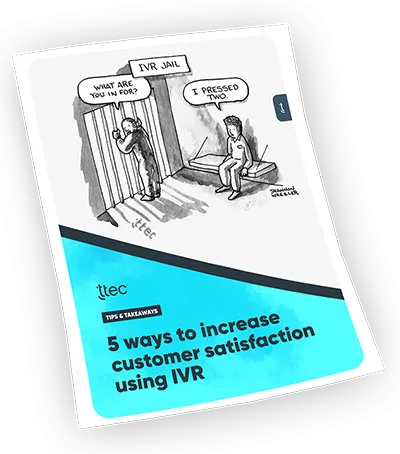Let’s face it: customers hate using Interactive Voice Response systems (IVRs). They particularly dislike having to enter a seemingly endless series of prompts, wondering if they’ll ever be able to have an issue resolved. It’s hardly surprising that the majority of customers are dissatisfied with their IVR experiences.
According to a study by New York University, a whopping 83 percent of consumers said IVRs either provide them with no benefit at all or are only provided as a cost savings opportunity for the companies that deploy them. Clearly, consumer sentiment still remains overwhelmingly negative toward Interactive Voice Response systems.
However, we wanted to dig a little deeper into how people feel about IVRs and explore the good, the bad, and the ugly, so our research team compiled a list of questions to determine not only what people dislike about these systems, but also what it is they really like about them as well. The main takeaway is that IVR systems are one contact center automation tool that customers love to hate, but the truth is — it’s really a love-hate relationship. And by understanding what IVRs can do well (and what consumers like them to do), we are able to determine effective ivr design strategy.
Below are 10 IVR menu design best practices as well as the findings of our research study.
The problem isn't contact center IVR technology, it is IVR design
Before we can look at IVR system best practices, it is essential to first understand what makes IVRs problematic to begin with. Certainly a key component of customer dissatisfaction with IVRs is that people don’t like to be forced to use a machine. In reality, however, the fault lies not with the technology, but with the implementation of the technology.
Today, companies not only force callers to enter information; they also play marketing messages, provide website information, outage information, and/or business hours and locations. This causes long delays and wait times when trying to reach an associate and can frustrate customers. No longer can customers ‘choose’ to use the automation; rather they’re often forced to use it as the only means to do business with that specific company or to resolve an issue. More and more companies started to embrace the IVR solution, causing customers to have a very limited number of options if they wanted to speak to an associate.
Let’s stop and picture, for a moment, how accepted bank ATMs would be if they were set up like IVR systems of today. Can the reader imagine a series of ATM machines at the entrance of a brick-and-mortar bank branch that all customers must interact with before the door will open? This interface theoretically is for the purpose of providing the customer with an easy way to perform simple transactions autonomously. It is an enhanced customer service tool. However, the perception would be that these machines block customers from getting access to the knowledgeable human employees eager to provide personalized and expedient service inside the bank. Would many people continue to use this bank and be satisfied? Would that affect the customers’ perceived value of the ATM machine? Any technology that stands in the way of a customer reaching a CSR would be just as quickly vilified and rejected as the IVR.
Now, we need to ask ourselves: If the IVR offers good customer support by providing helpful problem solving to most questions, why all the customer frustration and ill will toward IVR systems? We believe, based on our research, that customer frustration stems from the miscalculation of the limitations of automated self-service using voice response by the industry. An automated self-service system should provide the information to the customer in a clear, concise, and quick (CCQ) manner or transfer them so they can speak to an agent. And, like an ATM, no one should be forced to use it unless the business is closed.
How do you improve IVR design?
The first aspect is that IVR software needs to cater to the user, not to the company. This requires that the company review the business rules, associate skill group mapping, and gain up front information on who their customers are and what they may need based on the status of their accounts. An IVR system can be designed to be proactive by having the ability to access the customer database using either the Auto Number Identifier (ANI) provided, or request the caller’s account number. Once received, the system can review the account and provide information specific to that caller. For example, if he or she has a bill due within a few days of the call, ask “are you calling to make a payment?” or if they are past due “would you like to set up a payment plan?” When customer calls are transferred to an associate, the associate should know all the information that the caller provided to the IVR; and ask different security questions to ID the caller.
A customer-centric Voice User Interface (VUI) design can achieve and strengthen customer satisfaction by enabling users to navigate IVR options with ease and to get their tasks resolved quickly and efficiently. Here are 10 IVR design best practices to make IVR menus a desired go-to destination for customers:
1. Always provide customers with a live agent option.
Although an IVR menu should be designed so that it’s easy for customers to navigate and locate answers to their questions, the first rule of the IVR is providing customers with an option to reach a live associate. A well-designed IVR menu should continuously offer incoming calls a live associate option.
2. Make ‘call recording’ announcements only on transfers.
Customers understand that calls are often recorded for quality assurance purposes. But they don’t need to hear constant reminders of this – nor do they want to. Make call recording announcements known only when it’s necessary to do so.
3. Offer a non-primary language at the end of the initial menu.
Placing this option early in the IVR experience is helpful to customers and recognizes their needs and preferences.
4. Keep main menu options to 30 seconds.
Simplifying the main menu options strengthens the customer experience while making the IVR experience more efficient.
5. The IVR should sound like an associate.
VUI designers can further humanize the IVR experience by entering pre-recorded voice responses that sound like an associate. This includes using the right inflection and tone at the right moments (e.g., “You’re calling about your balance, is that right?”).
6. Use voice recognition and silence for turn-taking.
Strong voice recognition is important so the IVR software can provide natural pauses to allow customers to enter information or the option to speak just as they would in a conversation with an associate. Be sure to allow IVR users enough time to respond.
7. Allow barge-in for all prompts.
If your IVR application doesn’t have speech and voice recognition to allow callers to interrupt make sure the prompts are worded so that callers know they shouldn’t speak until the prompt is completed.
8.Make sure instructions are provided only when an error is made.
IVR users can easily become testy and frustrated with long messages or waiting times. There’s no need to further irritate them by issuing superfluous instructions.
9. Error correction should always use different words to re-prompt the caller.
One of the frustrations for IVR users is when they get stuck on a prompt or a command. To prevent this from happening, rephrase the options available for callers if they make a mistake with a prompt.
10. Information provided by a customer to the IVR should be extended to an associate in the contact center.
One of the greatest frustrations for customers is having to repeat information, so make sure when you route calls from the phone system to a live associate, the customer doesn't have to explain their request from the beginning again.
A well-designed IVR system is a win-win proposition
The bottom line is: If an IVR user interface is set up correctly, people are not only willing to use it; they would prefer to use it. However, if there are messages up front, too many options or menus deep without the ability to get to an associate (by pressing "0"), and long prompts, the callers will shut down and demand an associate. By following best practices such as shortening prompts, being both touch tone and speech enabled, and removing marketing or other superfluous informational messages, the customer will not hesitate to use the system. However, one bad system does ruin it for many good IVR systems. Hence, the popular disdain and ridicule for IVR calls is sustained and propagated as a sort of modern technology folklore.
This, of course, is where we come in. As part of our customer experience omnichannel solutions we fix inefficient IVR systems for our clients. We return to the core functionality of the business and partner with our customers to provide a more customer-centric environment. We have found that a well-designed IVR system, as part of a larger omnichannel contact center strategy, can be a win-win proposition for both the customer and the company that implements it. It not only provides better customer service it also assists in the reduction of overall call center costs by deflecting call volume to the automated self service that IVRs can provide.
A research study into IVR design best practices (and worst practices)
How has TTEC become such experts in contact center IVR design and implementation? Well, along with our years of experience, we have also conducted a deep-dive discovery into the best IVR experiences, how people feel about IVRs, and explore the good, the bad, and the ugly. For this research, our team compiled a list of questions to determine not only what people dislike about these systems, but also what it is they really like about them as well. The main takeaway is that IVR systems are one type of service automation that customers love to hate, but the truth is — it’s really a love-hate relationship. Based on our research findings, most customers dislike using IVRs, but appreciate them when the application provides clear, concise, and quick access to the information they need.
Three common IVR design flaws (and how to remedy them)
The study showed a significant portion of participants reporting basic IVR interaction challenges that can easily be overcome with the advanced IVR design principles, so this evidence should act as a call to action for business leaders to evaluate their IVR system for outdated technologies and improve IVR customer service by modernizing their IVR systems. Here are some ways to overcome common IVR design flaws:
Audio prompting: Audio prompting presents menus in a linear fashion, but there are a maximum number of prompts that callers are willing to listen to before they hit a point of frustration and forget the options offered. This intrinsic limitation means menu options should be clear, concise, quick, and avoid unnecessary messages before the menu options. Our rule of thumb is this: The time span between the start of the Welcome message and the end of the last main menu prompt should not exceed 30 seconds.
Upfront messages: Lengthy upfront messages, including marketing messages or website addresses, cause callers to tune out and stop listening to the prompts. The best IVRs will say only what the service associate would say when answering a call. These messages should be avoided: “Thank you for calling XYZ. Did you know you can get faster responses on our website? Please listen carefully to the following options.”
Speech recognition: The quality of the system’s speech recognition depends on the type of Automated Speech Recognition (ASR) engine and the grammar development behind the speech engine.
Do contact center IVRs take too long to navigate, or do they save people time?
While discussing what they don't like about Interactive Voice Response systems, 24 percent of participants complained about the time it takes to navigate through an automated system, but while discussing what they do like about IVRs, 19 percent of participants acknowledge that the automated system saves time—proving their love-hate sentiment toward IVRs.
Also interesting to note is that 16 percent of customers acknowledge the cost savings that IVRs deliver to companies as a positive attribute of the system. This indicates an overall acceptance and expectation to more frequently encounter IVRs and interact with non-human systems in today’s cost-focused, global economy. The key takeaway here is that while customers love to hate IVRs, they understand why businesses use them. So, it truly is their experience within the IVR system that really turns customers off. Business leaders should continue to leverage IVR strategy and implementation for the cost efficiencies but invest in upgrades that make them customer centric rather than business centric. Plus, these investments both lower costs and increase customer satisfaction; it should never be one or the other.
How do users prefer to interact with IVR systems?
An overwhelming 57 percent of customers prefer to use the touchtone keypad to enter their data, rather than speak it into the voice recognition system. Why? The survey’s open form responses indicated that users are still apprehensive about speech recognition problems.
The ability to bypass the automated system is a key call center ivr best practice
The results of our survey show that more than 60 percent of respondents prefer to speak with an associate, mostly because of considerations regarding efficiency, privacy, and speed of service. Thus, the option to bypass the automated system in order to talk to a human is a key ivr menu best practice. Here’s why. Unlike web and mobile automated systems, the IVR is forced on the customer rather than chosen by the customer. If a customer believes they need to speak to a human, the IVR functions as a non-optional intermediary, causing a sharp negative reaction toward the system. Of course, allowing a way to bypass the IVR and move directly to an associate requires more than just a strong IVR strategy - it is essential that you have a strong overall contact center solutions and customer care strategy in place.
Additional best practices for IVR system bypass features include:
- At no time should the caller be required to request an associate more than once.
- Callers should never hear that the system can assist them after they have requested an associate.
- Callers should have the option to return to the IVR if there is a long hold time.
Conclusion to our IVR best practices research study and other contact center IVR resources
IVR systems are one type of service automation that customers love to hate, but the truth is—it’s really a love-hate relationship. The next big thing in IVR technology will be connecting the contact center IVR solutions to customer management data, so it can provide more intelligent service with background information such as customer calling history, channel preference, and what the customer was doing when they requested service.

For now, though, transforming public opinion about IVRs will need to start with a simple customer-centric approach. IVR systems still have a long way to go before they will be considered the popular customer asset that many web or mobile applications are today; however, it is a realistic expectation when these systems are designed with the customer in mind. At TTEC Digital, our digital consulting and omnichannel technology team can help you evaluate your current interactive voice response systems to see how customer-centric they really are, and help you in the journey to implementing IVR best practices.
To learn more about how to leverage contact center IVR technology to make your call automation software work for customers, not against them, download our IVR cheat sheet 6 Tips to Prevent Customers from Saying “Agent” on Repeat.

















